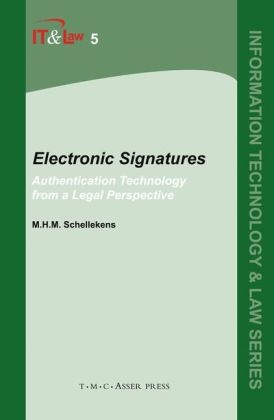Read more
With these issues the subject of legal usability is not completely covered. Enforcement is perhaps the most obvious issue that is not dealt with. There fore I will indicate for what reason enforcement has been omitted as a sepa rate issue. This has the following background. A signature may alleviate eviden tiary burdens that may arise when enforcing a contract, but enforcing a contract involves much more than evidence of the existence and contents of a contract. E-commerce has opened the possibility to engage in cross border business with a low value per transaction. Even if one has the authenticated identity of one's contracting party, it may still be too com plicated or expensive to commence legal proceedings against a party. A signature does not in itself result in compliance with contracts and legal rules. A digital signature may, however, be an important part of a more encompassing enforcement concept. The security dimension of signatures only makes sense if one is really willing to embark upon enforcement (in stead of accepting the loss). Enforcement in the Internet environment is not something that can be done on an ad hoc basis. The territorial division of the law hampers enforcement in the borderless Internet envi ronment: each country has its own system for determining and adminis tering law. Furthermore, traditional courts are not as yet tailored to the enforcement needs that originate from the Internet.
List of contents
Authentication Technology: An Elementary Explanation.- Usability of Authentication Technology.- Misuse and the Burden of Proof.- Privacy Implications of the Use of Electronic Signatures.- Conclusion.
About the author
Senior Researcher, Center for Law, Public Administration and Informatization, Tilburg University.
Summary
The contention that the provision of European Directives on functional legal requirements for digital signature validity solves a core problem of electronic commerce can at best be called naïve. The catch-phrase ‘what holds off line, holds online’ may be in tune with a general emotion towards the invasion of information technology into business; in this book it is made clear that there are no simple shortcuts for the lawyer who is concerned with authenticated digital transactions.
The author first sets out to describe the main aspects of authentication technologies, presenting the technical insights needed to get to the legal semantics of functional equivalence between traditional and digital signatures. The second part of his research focuses on the usability of authentication technology and what it entails for its users. Aspects considered are: qualification as electronic signature; limitations of electronic signatures; the electronic signature as evidence; alternatives to electronic signatures; liability and the burden of proof; and, last but not least, privacy concerns.
The research for this book is based on an in-depth literature study and interviews with highly qualified experts in the field. It provides valuable tools and background information not only for everyone active in or setting out on e-business in its widest concept, but also for practising lawyers and students of information technology.
Dr. Maurice Schellekens is a senior researcher at the Center for Law, Public Administration and Informatization of Tilburg University. He specializes in technology law, with a special emphasis on ICT and law.
This is Volume 5 in the Information Technology and Law (IT&Law) Series

